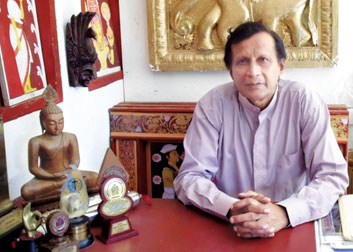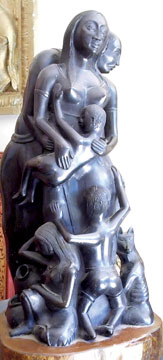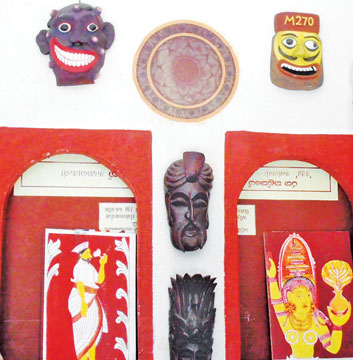|
Dayaratne Dolapihilla:
An award-winning mentor, craftsman and artiste
By Ganga Ratnayake
|

Dayaratne Dolapihilla |
It was my second visit to the renowned Kalapuraya – the crafts
village tucked in the midst of the charming countryside of Kundasale not
too far from the hill capital. Here I met the well-known craftsman
Dayaratne Dolapihilla in his gallery, brimming with exquisite sculptures
and paintings, where he began to relate about his life as a craftsman
counting five decades and more.
He is Dolapihille Gedara Dayaratne better known as Dayaratne
Dolapihilla hailing from Marathugoda, Harispattuwa in the Kandy
District.
Born on January 7, 1949 he completed his education at the Marathugoda
Maha Vidyalaya and Nugawela Central College and decided to follow in the
footsteps of his father D. Edoris, a school instructor specialised in
lacquer works with a fine knowledge in temple carpentry. Edoris was
among the few craftsmen families chosen to be settled in the newly built
Kalapuraya in 1965.
Dolapihilla studied craftsmanship under the guidance of his father
even before he turned 10, and later pursued vocational studies at the
Technical Colleges in Matale and Aruppola in Kandy and at a carpentry
institute in Moratuwa. Instead of specialising in one particular craft
Dolapihilla packed his arsenal with an assortment of talents ranging
from painting to sculpting, wedding poru, pandals, temple art and
traditional carpentry.
|

Mother and children |
Among his numerous creations is the beautifully carved wooden stand
of the Sabaragamu Province Senkolaya (mace).Since 1973 he ventured into
film and theatre background design and sculpting, contributing to 11
movies, both local and foreign. The movies include Gahanu Lamai, Seegiri
Kasyapa and Beyond Rangoon (filmed in Penang, Malaysia) and stage dramas
such as Sakuntala and Ratnawalli. He has worked with several renowned
Art Directors including J.A. Vincent, Wimal Jayawardena, Hemapala
Dharmasena, Errol Kelly and Chandran Ratnam.
Vivid memories
Among his vivid memories is the American adventure movie based on the
famous novel Jungle Book – ‘Second Jungle Book: Mowgli & Baloo’, which
was filmed in 1989 amid the lush green backdrops of Gannoruwa. He has
also toured many countries to design film sets, such as India, the
Philippines, Malaysia, Pakistan and Saudi Arabia.
While flipping through the pages of his portfolio, a sizeable photo
album, he eagerly shared titbits behind some of his exclusive props.
There were all kinds of props designed under diverse themes and their
dimensions ranged from a few inches to over several metres. Dolapihilla
has worked on a couple of massive creations while in Malaysia such as
the 60 ft long reclining Buddha statue and the 120 ft tall golden stupa
resembling Shwedagon Pagoda of Burma. Some photographs featured his
award winning sculptures presented at the Vishva Karma Exhibitions.
Among them a sculpture titled Saranagathayo won first place all island
in 1998, which portrays the tragedy of a family abandoned by the
breadwinner.
Dolapihilla also worked as a founding instructor of traditional
woodcrafts at the Battaramulla Jana Kala Kendraya (National Crafts
Village) from November 1988 to December 1995. During his tenure, he not
only shared his knowledge and experience with over 200 youth studying at
the training centre in Jana Kala Kendraya, but also trained several
woodcraft instructors. He played a key role in designing courses for
traditional carpentry and wood carvings in addition to producing two
handbooks, for the instructors and students.
At each annual Vishva Karma Awarding Ceremony and Exhibition at least
one of his students won an award. And so did their mentor, as
Dolapihilla too won several awards up to national level for his
enchanting woodcrafts and sculptures. In the 80’s he returned to his
home at Kalapuraya in Kundasale and continued to produce woodcrafts and
occasionally engaged in film set designing.
|

Some of his creation |
Due to many reasons
including the diminishing supply of wood, the sales of woodcraft
declined significantly, and he switched to making wedding poru. His poru
designs ranged from traditional to modern. They are aesthetically
pleasing as much as astrologically precise, for he incorporates the
exact traditional dimensions that is said to bring good fortune to the
couple.
Experience
Now at the age of 64, he still works just as hard as he did back in
his youth, yearning every moment for an opportunity to share his
knowledge and experience. His wife is a Fine Arts graduate and an art
teacher. He is blessed with three children, a son and two daughters who
have inherited his talents and creativity, and are presently pursuing
their own aspirations in various fields. His gallery was like a treasure
trove of innovation and creativity, silently whispering the many days
and weeks of meticulous toil and boundless commitment rendered to
produce them. There were lustrous woodcrafts and sculptures, attractive
p?ru designs, towering statues, fine wooden masks featuring the Kolam
tradition as well as beautiful Kandyan paintings to be used for a prop
of a stage drama.
He says the demand of customers and markets have changed dramatically
over the years that many seem to opt for cheap mass produced imitations
rather than original handcrafted products. As the demand for technology
increase, the thirst for traditional craftsmanship declines at the same
rate. Being a well-known craftsman, Dolapihilla holds several titles in
the Associations of Craftsmen and has won numerous awards and accolades
including President Award, Rathna Deepa Award, Kalabhooshana State
Award, and several regional awards for his refined artworks and
extensive services. Being a magnanimous person active in social work, he
is the consultant and instructor during every religious and national
function in the area. In the face of modernisation, technology and
market demands, he doesn’t give up and continues to support his fellow
traditional craftsmen, helping them gain more experience and make a name
for themselves in the country and beyond. |


